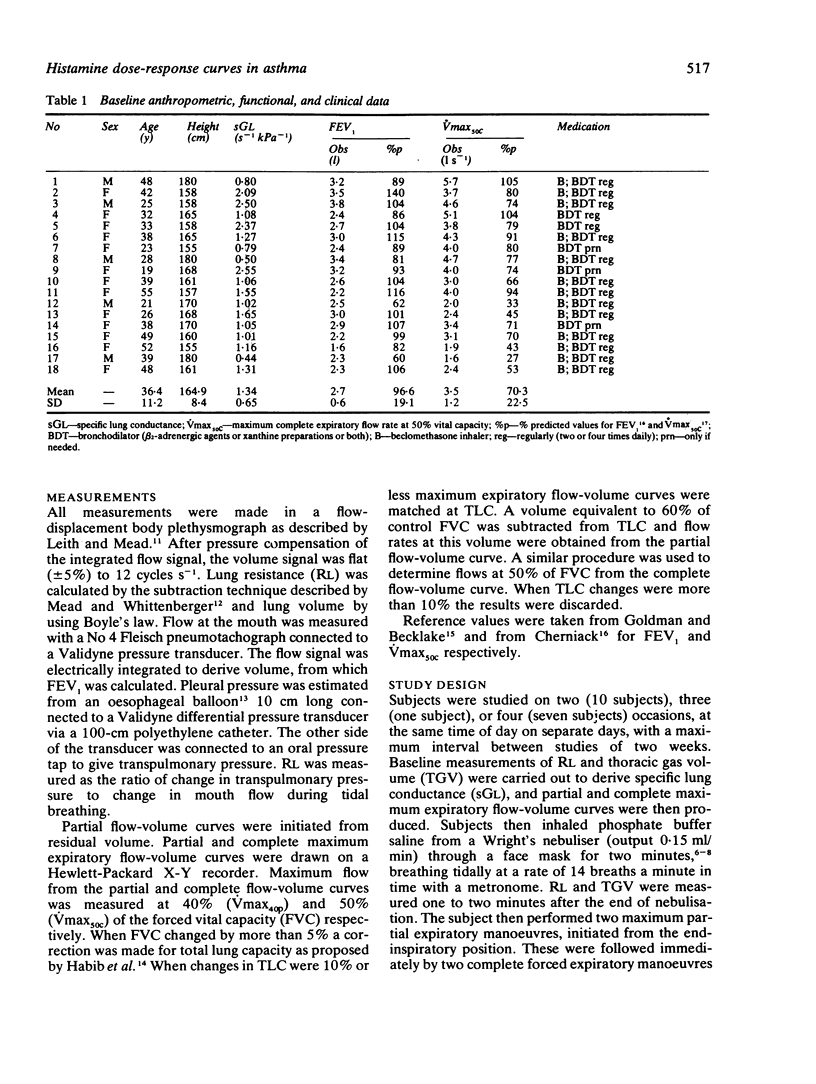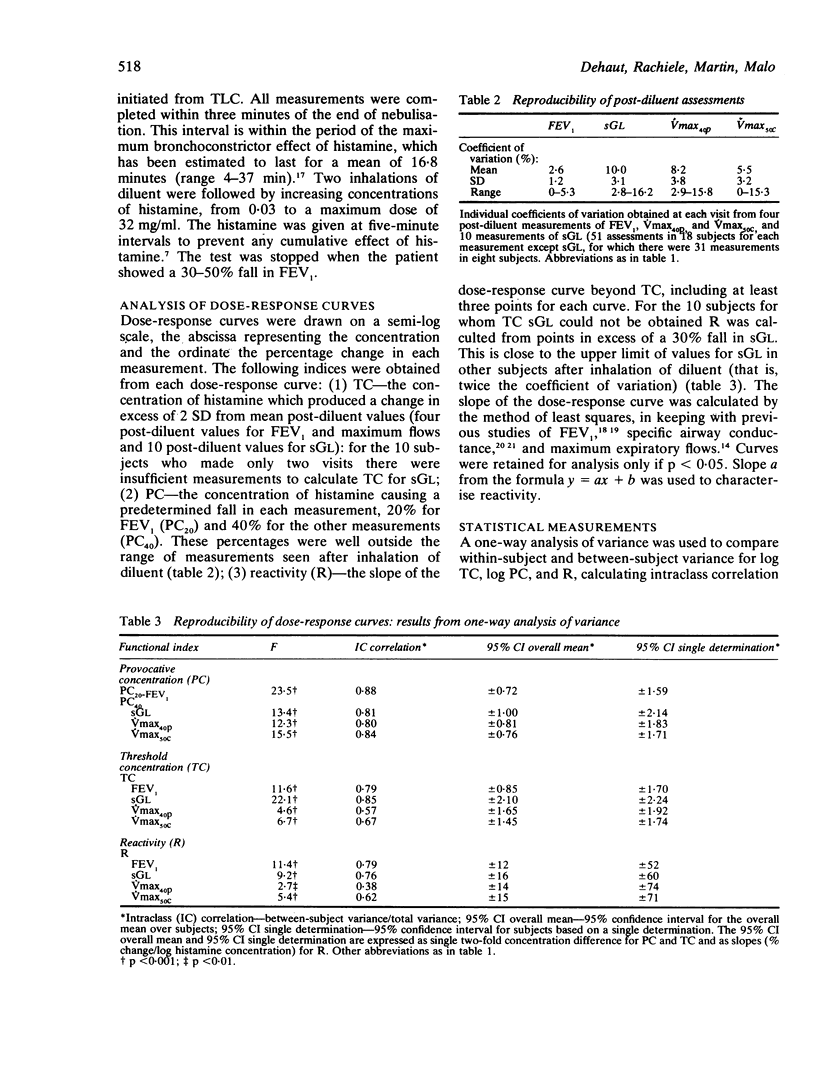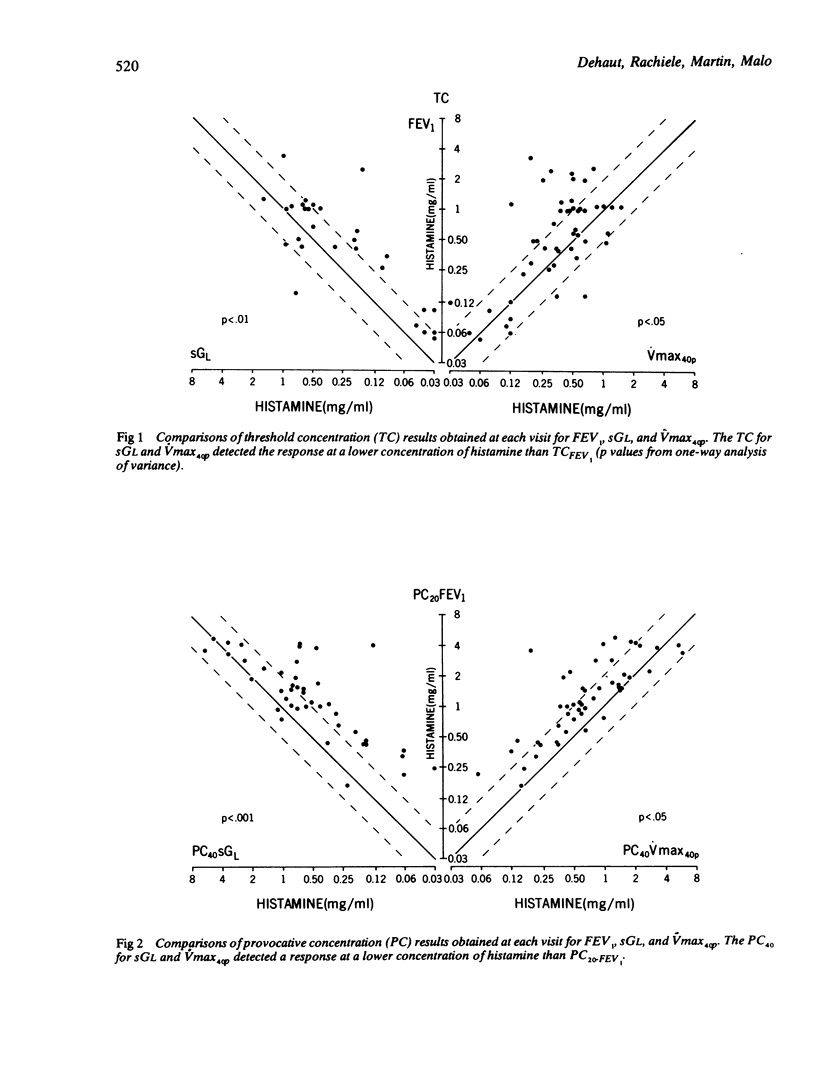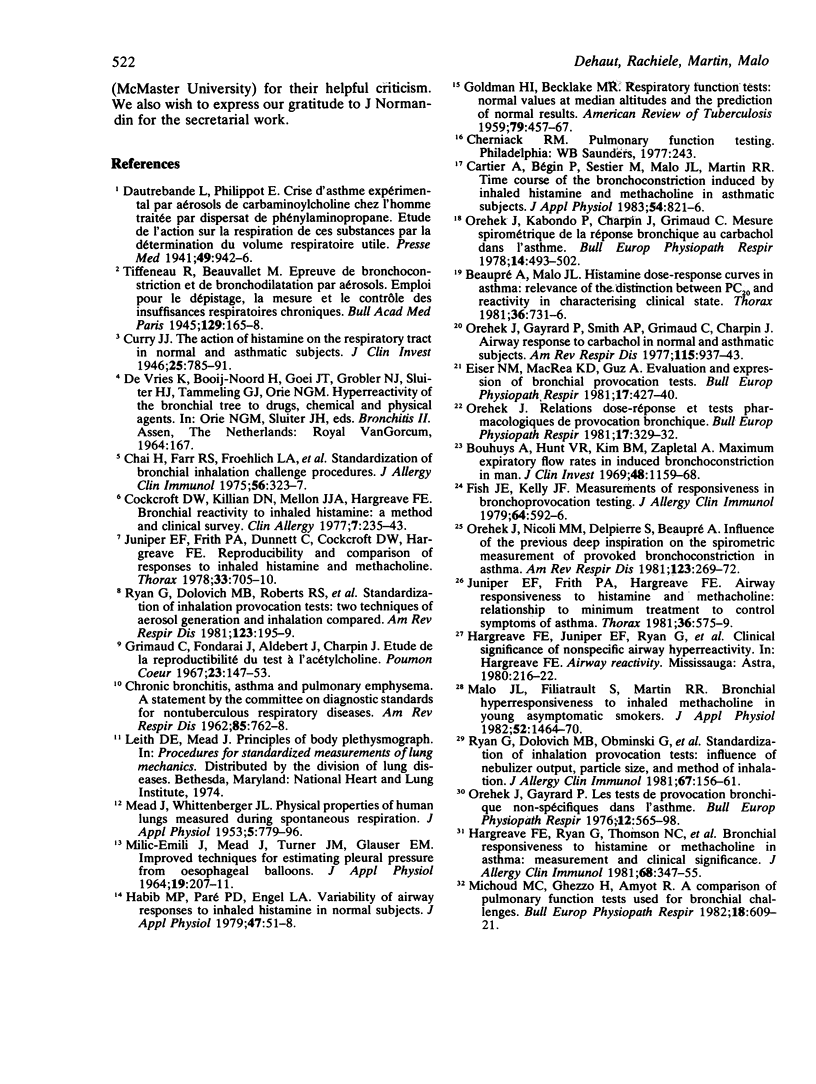Abstract
In 18 clinically stable asthmatic patients histamine inhalation challenges were performed with a Wright's nebuliser and tidal volume breathing for two minutes on two to four occasions for each subject at a maximum interval of two weeks. The response was measured in terms of specific lung conductance (sGL) by the subtraction technique, maximum partial and maximum complete expiratory flow at 40% and 50% of vital capacity respectively (Vmax40p and Vmax50c), and FEV1 from the maximum flow-volume curve. Dose-response curves were analysed for (1) provocative concentration (PC) of histamine causing a 20% fall in FEV1 and a 40% change in the other measurements; (2) threshold concentration (TC)--the concentration at which changes in the measurement exceed 2 SD from control values; (3) reactivity (R)--the slope of the dose-response curve beyond TC. We found that PC20-FEV1 was the most reproducible index, the 95% confidence intervals based on a single determination being +/- 1.6 single two-fold concentration difference. PC20-FEV1 was more reproducible than PC values for other measurements and more reproducible than any of the TC values. The 95% confidence intervals based on a single determination of R varied from +/- 52% to +/- 74% change/log histamine concentration. Both sGL and Vmax40p detected the bronchoconstrictor response assessed by PC and TC at a significantly lower histamine concentration than FEV1 (p less than 0.01 and p less than 0.05 respectively). PC and TC results showed a significant correlation, but neither were correlated with R.
Full text
PDF






Selected References
These references are in PubMed. This may not be the complete list of references from this article.
- Beaupré A., Malo J. L. Histamine dose-response curves in asthma: relevance of the distinction between PC20 and reactivity in characterising clinical state. Thorax. 1981 Oct;36(10):731–736. doi: 10.1136/thx.36.10.731. [DOI] [PMC free article] [PubMed] [Google Scholar]
- Bouhuys A., Hunt V. R., Kim B. M., Zapletal A. Maximum expiratory flow rates in induced bronchoconstriction in man. J Clin Invest. 1969 Jun;48(6):1159–1168. doi: 10.1172/JCI106073. [DOI] [PMC free article] [PubMed] [Google Scholar]
- Cartier A., Malo J. L., Bégin P., Sestier M., Martin R. R. Time course of the bronchoconstriction induced by inhaled histamine and methacholine. J Appl Physiol Respir Environ Exerc Physiol. 1983 Mar;54(3):821–826. doi: 10.1152/jappl.1983.54.3.821. [DOI] [PubMed] [Google Scholar]
- Chai H., Farr R. S., Froehlich L. A., Mathison D. A., McLean J. A., Rosenthal R. R., Sheffer A. L., Spector S. L., Townley R. G. Standardization of bronchial inhalation challenge procedures. J Allergy Clin Immunol. 1975 Oct;56(4):323–327. doi: 10.1016/0091-6749(75)90107-4. [DOI] [PubMed] [Google Scholar]
- Cockcroft D. W., Killian D. N., Mellon J. J., Hargreave F. E. Bronchial reactivity to inhaled histamine: a method and clinical survey. Clin Allergy. 1977 May;7(3):235–243. doi: 10.1111/j.1365-2222.1977.tb01448.x. [DOI] [PubMed] [Google Scholar]
- Curry J. J. THE ACTION OF HISTAMINE ON THE RESPIRATORY TRACT IN NORMAL AND ASTHMATIC SUBJECTS. J Clin Invest. 1946 Nov;25(6):785–791. doi: 10.1172/JCI101764. [DOI] [PMC free article] [PubMed] [Google Scholar]
- Eiser N. M., MacRae K. D., Guz A. Evaluation and expression of bronchial provocation tests. Bull Eur Physiopathol Respir. 1981;17(3):427–440. [PubMed] [Google Scholar]
- Fish J. E., Kelly J. F. Measurements of responsiveness in bronchoprovocation testing. J Allergy Clin Immunol. 1979 Dec;64(6 Pt 2):592–596. doi: 10.1016/0091-6749(79)90019-8. [DOI] [PubMed] [Google Scholar]
- GOLDMAN H. I., BECKLAKE M. R. Respiratory function tests; normal values at median altitudes and the prediction of normal results. Am Rev Tuberc. 1959 Apr;79(4):457–467. doi: 10.1164/artpd.1959.79.4.457. [DOI] [PubMed] [Google Scholar]
- Grimaud C., Fondarai J., Aldebert J., Charpin J. Etude de la reproductibilité du test à l'acétylcholine. Poumon Coeur. 1967;23(2):147–153. [PubMed] [Google Scholar]
- Hargreave F. E., Ryan G., Thomson N. C., O'Byrne P. M., Latimer K., Juniper E. F., Dolovich J. Bronchial responsiveness to histamine or methacholine in asthma: measurement and clinical significance. J Allergy Clin Immunol. 1981 Nov;68(5):347–355. doi: 10.1016/0091-6749(81)90132-9. [DOI] [PubMed] [Google Scholar]
- Juniper E. F., Frith P. A., Dunnett C., Cockcroft D. W., Hargreave F. E. Reproducibility and comparison of responses to inhaled histamine and methacholine. Thorax. 1978 Dec;33(6):705–710. doi: 10.1136/thx.33.6.705. [DOI] [PMC free article] [PubMed] [Google Scholar]
- Juniper E. F., Frith P. A., Hargreave F. E. Airway responsiveness to histamine and methacholine: relationship to minimum treatment to control symptoms of asthma. Thorax. 1981 Aug;36(8):575–579. doi: 10.1136/thx.36.8.575. [DOI] [PMC free article] [PubMed] [Google Scholar]
- MILIC-EMILI J., MEAD J., TURNER J. M., GLAUSER E. M. IMPROVED TECHNIQUE FOR ESTIMATING PLEURAL PRESSURE FROM ESOPHAGEAL BALLOONS. J Appl Physiol. 1964 Mar;19:207–211. doi: 10.1152/jappl.1964.19.2.207. [DOI] [PubMed] [Google Scholar]
- Malo J. L., Filiatrault S., Martin R. R. Bronchial responsiveness to inhaled methacholine in young asymptomatic smokers. J Appl Physiol Respir Environ Exerc Physiol. 1982 Jun;52(6):1464–1470. doi: 10.1152/jappl.1982.52.6.1464. [DOI] [PubMed] [Google Scholar]
- Michoud M. C., Ghezzo H., Amyot R. A comparison of pulmonary function tests used for bronchial challenges. Bull Eur Physiopathol Respir. 1982 Jul-Aug;18(4):609–621. [PubMed] [Google Scholar]
- Orehek J., Gayrard P. Les tests de provocation bronchique non-spécifiques dans l'asthme. Bull Eur Physiopathol Respir. 1976 Jul-Aug;12(4):565–598. [PubMed] [Google Scholar]
- Orehek J., Gayrard P., Smith A. P., Grimaud C., Charpin J. Airway response to carbachol in normal and asthmatic subjects: distinction between bronchial sensitivity and reactivity. Am Rev Respir Dis. 1977 Jun;115(6):937–943. doi: 10.1164/arrd.1977.115.6.937. [DOI] [PubMed] [Google Scholar]
- Orehek J., Kabondo P., Charpin J., Grimaud C. Mesure spirométrique de la réponse bronchique au carbachol dans l'asthme. Bull Eur Physiopathol Respir. 1978 Sep-Oct;14(5):493–502. [PubMed] [Google Scholar]
- Orehek J., Nicoli M. M., Delpierre S., Beaupre A. Influence of the previous deep inspiration on the spirometric measurement of provoked bronchoconstriction in asthma. Am Rev Respir Dis. 1981 Mar;123(3):269–272. doi: 10.1164/arrd.1981.123.3.269. [DOI] [PubMed] [Google Scholar]
- Orehek J. Relations dose-reponse et tests pharmacologiques de provocation bronchique. Bull Eur Physiopathol Respir. 1981;17(3):329–332. [PubMed] [Google Scholar]
- Ryan G., Dolovich M. B., Obminski G., Cockcroft D. W., Juniper E., Hargreave F. E., Newhouse M. T. Standardization of inhalation provocation tests: influence of nebulizer output, particle size, and method of inhalation. J Allergy Clin Immunol. 1981 Feb;67(2):156–161. doi: 10.1016/0091-6749(81)90012-9. [DOI] [PubMed] [Google Scholar]
- Ryan G., Dolovich M. B., Roberts R. S., Frith P. A., Juniper E. F., Hargreave F. E., Newhouse M. T. Standardization of inhalation provocation tests: two techniques of aerosol generation and inhalation compared. Am Rev Respir Dis. 1981 Feb;123(2):195–199. doi: 10.1164/arrd.1981.123.2.195. [DOI] [PubMed] [Google Scholar]


